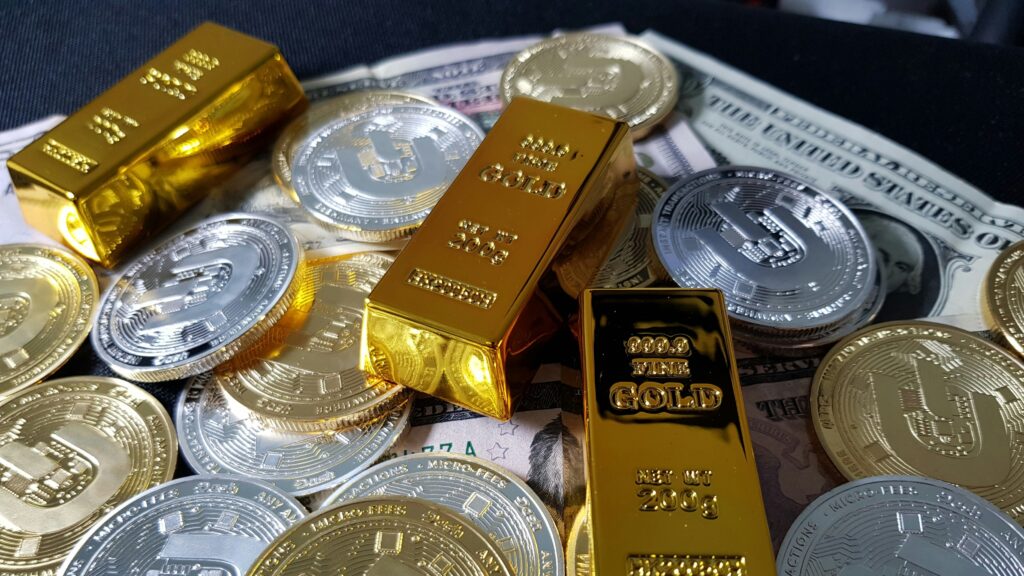Precious Metals
For centuries, gold and silver have been symbols of wealth and power. Kings hoarded them, wars were fought over them, and even today, investors still flock to precious metals when the economy looks shaky. But should you be investing in precious metals like gold, silver, or other metals? Or are you better off sticking to stocks and real estate?

The answer: It depends. Gold can be a safe haven or a slow-moving investment. Silver has industrial demand but is highly volatile. And newer players like platinum and palladium are catching investor interest.
Before you start stacking gold bars in your basement, let’s break down how precious metals work as an investment, their pros and cons, and whether they belong in your portfolio.
Why People Like Investing in Precious Metals
Precious metals have long been viewed as a hedge against uncertainty. When the economy shakes, inflation rises, or stock markets tumble, gold and silver tend to hold their value—or even increase. They provide a sense of security that digital assets and paper money don’t offer. Unlike stocks, which are subject to corporate earnings and market volatility, precious metals exist in their purest form. They have value because the world agrees they do.
Beyond just storing value, metals serve a key role in diversification. Since they don’t move in sync with the stock market, holding a percentage of your portfolio in gold or silver can reduce overall risk. And while they don’t generate passive income like real estate or dividends, they offer something those assets can’t: tangibility. You can hold them, store them, and they’re never at risk of “going bankrupt.”
Gold: The “Safe Haven” Asset
Gold has earned its reputation as the ultimate store of value. Unlike fiat currencies, which can be printed at will, gold is finite. Central banks hold it in reserves, governments use it as a financial backstop, and investors rush toward it in times of economic turmoil.
Historically, gold has thrived when the world is in crisis mode. During recessions, geopolitical uncertainty, and stock market crashes, gold prices often rise sharply. For example, in 2008, while the stock market was in free fall, gold surged over 25%. Similarly, in 2020, during the pandemic, gold hit an all-time high of $2,075 per ounce as investors scrambled for safety.
That said, gold’s long-term performance isn’t as impressive as the stock market. Over the last 50 years, gold has averaged around 8% annual returns—solid, but slower than a well-diversified portfolio of stocks. It’s a defensive asset rather than a growth engine, which is why many investors use it as a hedge rather than a wealth builder.
When it comes to buying gold, there are multiple options. Some prefer the physical route, investing in gold coins or bars, which can be stored at home or in a secure vault. Others go the paper route, opting for gold-backed ETFs or mining stocks, which provide exposure without the hassle of physical storage. And for those who like to trade, gold futures and options allow for leveraged bets on price movements—though they come with significant risk.
If stability is your priority, gold is one of the most time-tested assets in existence. But if you’re looking for rapid appreciation, there may be better options.
Silver: The Volatile Underdog
Silver often plays second fiddle to gold, but it’s far more than just “poor man’s gold.” While it shares many of the same store-of-value properties, silver has an additional factor driving its price: industrial demand.
Unlike gold, which is primarily used for investment and jewelry, silver is heavily utilized in solar panels, electronics, medical devices, and batteries. This industrial use gives silver an extra layer of demand, but also makes it far more volatile. When economic growth is strong, silver can see massive gains, but when industries slow down, its price can plunge.
Historically, silver’s price movements have been dramatic. In the 1970s, silver skyrocketed over 800% before crashing back down. In 2011, silver hit $50 per ounce, only to lose 70% of its value shortly after. While this makes it an exciting asset for traders, it also means silver is far less stable than gold.
For investors looking to get in on silver, there are similar options as with gold. You can purchase physical silver, invest in silver ETFs, or buy shares in silver mining companies. But be warned: silver swings hard, so it requires a strong stomach.
Platinum & Palladium: The Industrial Metals
Platinum and palladium aren’t as well-known as gold and silver, but they have a critical role in modern technology. Both metals are used heavily in catalytic converters for cars, making their demand tied closely to the auto industry.
Palladium, in particular, has been a standout performer over the last decade, even surpassing gold in price at times. But because demand for these metals is largely industrial, their price is far more cyclical. If the auto industry slows down, platinum and palladium prices often take a hit.
Investing in these metals is more speculative, but for those looking to diversify into alternative assets, they offer an interesting play.
Pros & Cons of Investing in Precious Metals
| Pros | Cons |
|---|---|
| ✅ Safe haven during crises | ❌ Not income-producing (like stocks/real estate) |
| ✅ Hedge against inflation | ❌ Price swings can be extreme |
| ✅ Physical asset (not just a number on a screen) | ❌ Storage & security costs (if buying physical metals) |
| ✅ Diversifies your portfolio | ❌ Gold & silver move slow over long periods |
How Much Should You Invest in Precious Metals?
Experts suggest 5-10% of your portfolio in precious metals for diversification.
Example: If you have $50,000 to invest, putting $2,500 in gold or silver could be a smart hedge—but going all-in on metals? Probably not.
Final Thoughts: Should You Be Investing in Precious Metals?
If you want:
- A hedge against inflation & economic downturns → Gold is a solid choice.
- More volatility & industrial demand → Silver has higher swings.
- A speculative high-risk play → Platinum & palladium offer big swings.
But if you’re looking for steady, long-term growth? Stocks, ETFs, and real estate might be better investments.
